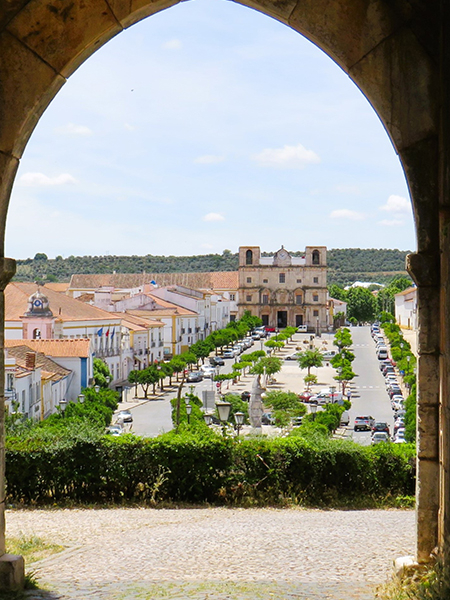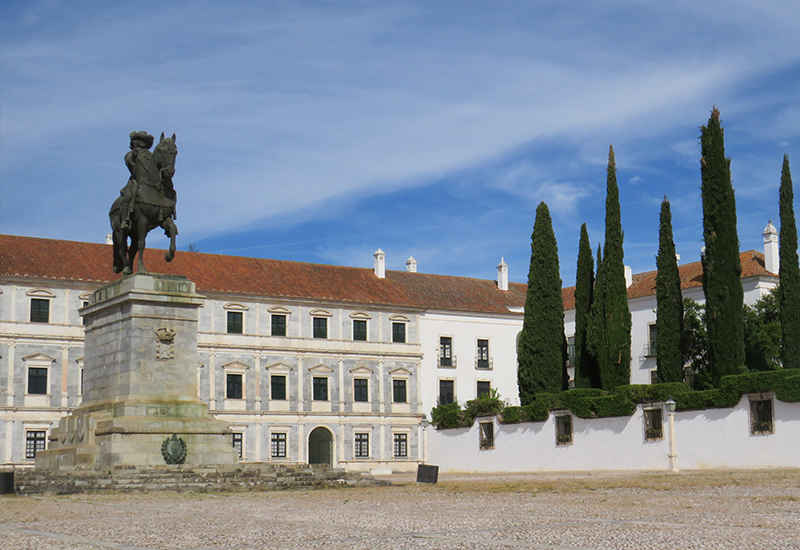As enthusiastic hikers, our holidays have almost always focused on walking. In April, a leg injury (mine) forced us to rethink our travel plans. Thus, we found ourselves embarking on an Alentejo road trip.
We’d never been on a road trip before so we weren’t sure where to start. Did we plan our whole journey in advance or head where our fancy took us each day? As we’d originally planned to walk the Grande Rota do Guadiana (GR15), we decided to stick with Portugal … maybe venturing into Spain occasionally. Harri, my partner, liked the idea of some border hopping.
The problem with planning a Portuguese road trip, we soon discovered, is the abundance of possibilities. Which of the many fortified hilltop towns and villages should we visit? We’d called in at Elvas and Évora when we drove down to the Algarve in 2018 to start our new life here – should we return to these tried-and-tested places or venture into the unknown? We hadn’t faced these decisions when we walked the Fisherman’s Trail last May.
With our travel plans still up in the air, my leg was getting better. We didn’t want to tempt fate – legs can be quite contrary – but this happy development meant ours could perhaps be a road trip interspersed with local pequenas rotas (PR). Though with ‘local’ still undecided, this involved Harri downloading a lot of GPX files.
We set off with two nights’ accommodation pre-booked in Mértola and a determination to visit the Serra de São Mamede, slightly north of Lisbon on the Spain-Portugal border, at some point. This was going to be an adventure.

Mértola
The traffic-free and picturesque road from Almodôvar to Mértola will remain forever in my memory as the bumpiest 40 kilometres we’ve driven in Portugal … ever. We stopped just short of Mértola to enjoy a short walk above the Guadiana river, coincidentally part of the route we’d have walked if we’d stuck with our original plans.
We arrived in our first Alentejo town full of anticipation, but Mértola was deserted, possibly because the Islamic festival was taking place later that month. There’s no denying the location of this pretty, whitewashed town is spectacular; however, there’s not really a lot to explore, so after we’d taken in the historic centre, the castle and the fascinating remains of the old port and wharf, we wandered over to the Núcleo Visigótico to see the Roman artifacts (and provide the friendly curator with a list of Roman sites she really should visit in South Wales).


Mina de São Domingos
An absolute must and a highlight of our trip. This former mining village sits between two lakes – Tapada Grande (with its river beach) and Tapada Pequena. From the 19th century to the mid-sixties, millions of tons of sulphur pyrite were mined here for use in copper extraction. Tiny, single-storey miners’ houses line the contours of the hill, much like terraced housing in coal mining villages, except here the homes had no private outdoor space. In stark contrast, the nearby ‘English Neighbourhood and Gardens’ provided the mining elite from Mason & Barry Limited with leafy walkways, a tennis court and even a bandstand.

We rather ambitiously decided to tackle two PR routes: PR4 MTL: Around the Montado and PR10 MTL: The mining route of São Domingos. The first introduced us to the vast undulating fields of the Alentejo, where cattle and sheep grazed peacefully, the second to the massively destructive nature of mining. Heap spoils of ore had been abandoned, while ‘poison’ signs flanked the numerous rust-coloured cooling pools. Swirling dust clouds engulfed us several times as we trekked along the disused railway embankment.

Moura
Moura’s narrow streets were hot: Alentejo hot. The abundance of water was reflected in the city’s vibrant floral offerings, with Rua das Flores living up to its name. The promising sounding PR2 MRA: Route of the water of Moura, did not. Fortunately, a mutinous local had kicked down an offending fence and left a rowing boat under the trees, so we were able to get within peering distance of the Rio Ardila. Moura’s 13th-century castle was blown up by the Spanish in 1707, but the keep and castle walls are well-maintained and the grass sprinklers cooled us down.


Vila Viçosa
The marble capital of Portugal is famous for its association with the Dukes of Bragança (heirs to the Portuguese throne), who owned huge estates here. Substantial properties and orange trees line the wide avenues, reflecting the wealth the ‘white gold’ and royal patronage brought to the town. The pièce de résistance is, of course, the lavish Paço Ducal which stands at one end of a huge cobbled square (dominated by a towering statue of João IV on horseback) and stretches a full 110 metres. Entry (8€) was afternoon only, with additional charges to explore separate rooms and all tours were in Portuguese. Preferring to stay outdoors, we opted to walk the ‘Royal Road’, which historically linked Vila Viçosa to Elvas. It was perfect. We meandered through the verdant, dry-walled landscape like characters in Last of the Summer Wine, the tranquillity broken only by the tinkling of cow bells and croaking of frogs.
Estremoz
Estremoz boasts incredible medieval castle walls with two well-preserved gateways and a 28-metre marble keep. From the ramparts, there are far-reaching views across the Alentejo’s vineyards, olive groves and wheat fields. The old city is magnificent, if a little dilapidated in places; however, the Rossio, the main square in the lower town, and the fountains were impressive. Our visit was too short.

Castelo de Vide
Our road trip ended in this beautiful, alpine-like town, famous for being the birthplace of Fernando José Salgueiro Maia, the army captainwho led the revolutionary forces during the Carnation Revolution of 25 April 1974 (see article in Tomorrow, April 2023 edition). His revered status is evident everywhere and a modern museum is dedicated to his life and achievements.


Here, the castle dominates the landscape (cross that sloping roof to the tower at your peril!) and, within the fortifications, the distinction between natural rock and built properties somewhat blurs – a US friend’s kitchen ‘wall’ is actually a large boulder. We stayed in the Jewish Quarter, a labyrinth of steep, cobbled streets full of potted geraniums, prowling cats and low-arched Gothic doorways.
Castelo de Vide boasts many beautiful fountains, including the 16th-century Fonte da Vila with its six marble columns and another with a line of marble dolphins spouting water from their mouths. There is a legend claiming anyone who drinks from the Fonte da Mealhada will return here to get married.
We gazed at the surrounding landscape from the castle and then climbed to the Chapel of Nossa Senhora da Penha on the opposite hill to gaze back at Castelo da Vide.

Marvão
A must-see for anyone visiting the Alto Alentejo, though surprisingly untouristy. We followed medieval footpaths from Castelo de Vide and walked through a magical forest of Pyrenean oak to reach this hilltop paradise. The final uphill kilometres were a hard slog, a feat described as being only for demigods, but the far-reaching views – and the lively folk music at a bombeiros fundraising event – made every step worthwhile.

Hiking beats driving
After a week, we were tired of constantly moving on. My leg was fully recovered, so we abandoned our road trip to focus on what we love best: hiking.
We extended our stay in Castelo de Vide to eight nights and hiked every day. We found a bar selling craft beers and even managed to briefly cross into Spain to La Fontañera (on PR4 MVR: The coffee smuggling route). Our road trip was wonderful but, for us, hiking will always beat driving.













